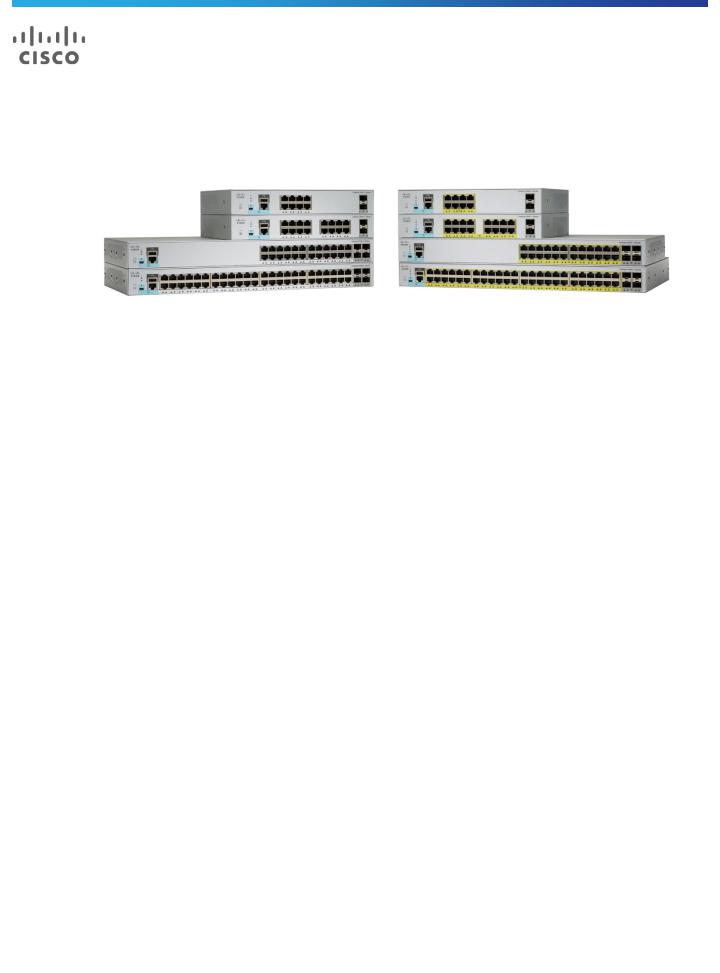Cisco Catalyst 2960-L User Manual

Data Sheet
Cisco Catalyst 2960-L Series Switches
Product overview
Cisco® Catalyst® 2960-L Series Switches are fixed-configuration, Gigabit Ethernet switches that provide Layer 2 and basic Layer 3 enterprise-class access switching for branch offices, conventional workspaces, and out-of-the- wiring-closet applications. These Cisco IOS® Software based switches are fanless, easy to use, energy efficient, cost-effective, reliable, and secure.
Product highlights
Cisco Catalyst 2960-L switches feature:
●8, 16, 24, or 48 Gigabit Ethernet ports with line-rate forwarding
●4 Enhanced Small Form-Factor Pluggable (SFP+) uplinks
●2 or 4 Gigabit Small Form-Factor Pluggable (SFP) uplinks
●Basic routing features: Static routing and Routing Information Protocol (RIP)
●Power over Ethernet Plus (PoE+) support with up to 370W of power budget
●Perpetual PoE provides uninterrupted power to connected devices even when the switch is booting
●Fanless operation and operational temperature up to 45°C for deployment outside the wiring closet
●Higher Mean Time Between Failure (MTBF) because they have no moving mechanical parts
●Less than 11.5-inch depth fit in use cases with space limitation
●Reduced power consumption and advanced energy management features
●RJ45 and USB console access for simplified operations
●Intuitive web UI for easy deployment and management
●Over-the-air configuration and management via Bluetooth interface
●Enhanced Limited Lifetime Warranty (E-LLW) offering next-business-day hardware replacement
© 2017 Cisco and/or its affiliates. All rights reserved. This document is Cisco Public Information. |
Page 1 of 12 |

Switch models and configurations
Cisco Catalyst 2960-L Series Switches include a single fixed power supply. Table 1 shows configuration information.
Table 1. |
Cisco Catalyst 2960-L Series configurations |
|
|
|
||||
|
|
|
|
|
|
|
|
|
Product ID* |
|
10/100/1000 |
Uplink |
Available |
Fanless |
Dimensions (H x D x W) |
Weight |
|
|
|
Ethernet |
interfaces |
PoE power |
|
|
|
|
|
|
ports |
|
|
|
|
|
|
|
|
|
|
|
|
|
|
|
WS-C2960L-8TS-LL |
8 |
2 |
SFP |
– |
Y |
1.73 x 8.45 x 10.56 in. (4.4 x 21.5 x 26.8 cm) |
3.33 lb (1.51kg) |
|
|
|
|
|
|
|
|
|
|
WS-C2960L-8PS-LL |
8 |
2 |
SFP |
67W |
Y |
1.73 x 9.45 x 10.56 in. (4.4 x 24 x 26.8 cm) |
4.50 lb (2.04kg) |
|
|
|
|
|
|
|
|
|
|
WS-C2960L-16TS-LL |
16 |
2 |
SFP |
– |
Y |
1.73 x 8.45 x 10.56 in. (4.4 x 21.5 x 26.8 cm) |
3.41 lb (1.55kg) |
|
|
|
|
|
|
|
|
|
|
WS-C2960L-16PS-LL |
16 |
2 |
SFP |
120W |
Y |
1.73 x 9.45 x 10.56 in. (4.4 x 24 x 26.8 cm) |
4.65 lb (2.11kg) |
|
|
|
|
|
|
|
|
|
|
WS-C2960L-24TS-LL |
24 |
4 |
SFP |
– |
Y |
1.73 x 9.45 x 17.5 in. (4.4 x 24 x 44.5 cm) |
6.04 lb (2.74kg) |
|
|
|
|
|
|
|
|
|
|
WS-C2960L-24PS-LL |
24 |
4 |
SFP |
195W |
Y |
1.73 x 10.45 x 17.5 in. (4.4 x 26.5 x 44.5 cm) |
7.41 lb (3.36kg) |
|
|
|
|
|
|
|
|
|
|
WS-C2960L-48TS-LL |
48 |
4 |
SFP |
– |
Y |
1.73 x 9.45 x 17.5 in. (4.4 x 24 x 44.5 cm) |
6.57 lb (2.98kg) |
|
|
|
|
|
|
|
|
|
|
WS-C2960L-48PS-LL |
48 |
4 |
SFP |
370W |
N |
1.73 x 11.5 x 17.5 in. (4.4 x 29.2 x 44.5 cm) |
10.08 lb (4.57kg) |
|
|
|
|
|
|
|
|
|
|
WS-C2960L-24TQ-LL |
24 |
4 |
SFP+ |
– |
Y |
1.73 x 9.45 x 17.5 in (4.4 x 24 x 44.5 cm) |
6.06 lb (2.75kg) |
|
|
|
|
|
|
|
|
|
|
WS-C2960L-24PQ-LL |
24 |
4 |
SFP+ |
195W |
Y |
1.73 x 10.45 x 17.5 in (4.4 x 26.5 x 44.5 cm) |
7.39 lb (3.35kg) |
|
|
|
|
|
|
|
|
|
|
WS-C2960L-48TQ-LL |
48 |
4 |
SFP+ |
– |
Y |
1.73 x 9.45 x 17.5 in (4.4 x 24 x 44.5 cm) |
6.68 lb (3.03kg) |
|
|
|
|
|
|
|
|
|
|
WS-C2960L-48PQ-LL |
48 |
4 |
SFP+ |
370W |
N |
1.73 x 11.5 x 17.5 in (4.4 x 29.2 x 44.5 cm) |
9.81 lb (4.54kg) |
|
|
|
|
|
|
|
|
|
|
*Please refer to local price lists for full product SKUs.
Features and benefits
All Cisco Catalyst 2960-L Series Switches feature a LAN Lite Cisco IOS Software image, providing basic functionality for small-scale deployments.
For more information about the features included in the LAN Lite feature sets, refer to the Cisco Feature Navigator: https://tools.cisco.com/ITDIT/CFN/jsp/index.jsp.
Basic routing features
●Routing Information Protocol (RIP) is a commonly used routing protocol in small to medium-sized TCP/IP networks. It is supported in both IPv4 and IPv6 network environments.
●Static routing is used to segment the network into separate workgroups and communicate across VLANs without degrading application performance.
Network security
The Cisco Catalyst 2960-L Series Switches provide a range of security features to limit access to the network and mitigate threats, including:
●Comprehensive 802.1X features to control access to the network, including flexible authentication, 802.1X monitor mode, and RADIUS change of authorization.
●Multi-domain authentication allows an IP phone and a PC to authenticate on the same switch port while placing them on appropriate voice and data VLANs.
© 2017 Cisco and/or its affiliates. All rights reserved. This document is Cisco Public Information. |
Page 2 of 12 |

●Access control lists (ACLs) for IPv6 and IPv4 for security and quality-of-service (QoS) ACL elements (ACEs):
◦ Port-based ACLs for Layer 2 interfaces allow security policies to be applied on individual switch ports.
●Secure Shell (SSH) Protocol, Kerberos, and Simple Network Management Protocol Version 3 (SNMPv3) provide network security by encrypting administrator traffic during Telnet and SNMP sessions. SSH Protocol, Kerberos, and the cryptographic version of SNMPv3 require a special cryptographic software image because of U.S. export restrictions.
●Switched Port Analyzer (SPAN), with bidirectional data support, allows Cisco Intrusion Detection System (IDS) to take action when an intruder is detected.
●TACACS+ and RADIUS authentication facilitates centralized control of the switch and restricts unauthorized users from altering the configuration.
●MAC address notification allows administrators to be notified about users added to or removed from the network.
●Multilevel security on console access prevents unauthorized users from altering the switch configuration.
●Bridge Protocol Data Unit (BPDU) guard shuts down spanning-tree port fast–enabled interfaces when BPDUs are received to avoid accidental topology loops.
●Spanning-Tree Root Guard (STRG) prevents edge devices not in the network administrator’s control from becoming Spanning Tree Protocol root nodes.
●IGMP filtering provides multicast authentication by filtering out nonsubscribers and limits the number of concurrent multicast streams available per port.
●Dynamic VLAN assignment is supported through implementation of VLAN membership policy server client capability to provide flexibility in assigning ports to VLANs. Dynamic VLAN facilitates the fast assignment of IP addresses.
Redundancy and resiliency
Cisco Catalyst 2960-L Series Switches offer a number of redundancy and resiliency features to prevent outages and help ensure that the network remains available:
●IEEE 802.1s/w Rapid Spanning Tree Protocol (RSTP) and Multiple Spanning Tree Protocol (MSTP) provide rapid spanning-tree convergence independent of spanning-tree timers and also offer the benefits of Layer 2 load balancing and distributed processing.
●Per-VLAN Rapid Spanning Tree (PVRST+) allows rapid spanning-tree reconvergence on a per-VLAN spanning-tree basis, without requiring the implementation of spanning-tree instances.
●Switch-port autorecovery (error disable) automatically attempts to reactivate a link that is disabled because of a network error.
Enhanced quality of service
The Cisco Catalyst 2960-L Series Switches offer intelligent traffic management that keeps everything flowing smoothly. Flexible mechanisms for marking, classification, and scheduling deliver superior performance for data, voice, and video traffic, all at wire speed. Primary QoS features include:
●Up to four egress queues and two thresholds per port supporting egress bandwidth control, shaping, and priority queuing so that the high priority packets are serviced ahead of other traffic.
© 2017 Cisco and/or its affiliates. All rights reserved. This document is Cisco Public Information. |
Page 3 of 12 |

●Shaped Round Robin (SRR) scheduling and Weighted Tail Drop (WTD) congestion avoidance.
●802.1p Class of Service (CoS) classification, with marking and reclassification.
Intelligent Power over Ethernet Plus
Cisco Catalyst 2960-L Series Switches support both IEEE 802.3af Power over Ethernet (PoE) and IEEE 802.3at PoE+ (up to 30W per port) to deliver lower total cost of ownership for deployments that incorporate Cisco IP Phones, Cisco Aironet® wireless access points, or other standards-compliant PoE/PoE+ end devices. PoE removes the need to supply wall power to PoE-enabled devices and eliminates the cost of adding electrical cabling and circuits that would otherwise be necessary in IP phone and WLAN deployments.
The Cisco Catalyst 2960-L Series PoE power allocation is dynamic, and power mapping scales up to a maximum of 370W PoE+ power. Intelligent power management allows flexible power allocation across all ports. With Perpetual POE, the POE power is maintained during a switch reload. This is important for critical endpoints such as medical devices and IOT endpoints such as POE-powered lights so that there is no disruption during switch reboot.
Cisco Catalyst SmartOperations
Cisco Catalyst SmartOperations is a comprehensive set of capabilities that simplify LAN planning, deployment, monitoring, and troubleshooting. Deploying SmartOperations tools reduces the time and effort required to operate the network and lowers TCO.
●Loop detection is a new method to detect network loops in the absence of Spanning Tree Protocol (STP).
●Cisco AutoConfig services determine the level of network access provided to an endpoint based on the type of the endpoint device. This feature also permits hard binding between the end device and the interface.
●Cisco Smart Install services enable minimal-touch deployment by providing automated Cisco IOS Software image installation and configuration when new switches are connected to the network. This enables network administrators to remotely manage Cisco IOS Software image installs and upgrades.
●Cisco Auto SmartPorts services enable automatic configuration of switch ports as devices connect to the switch with settings optimized for the device type resulting in zero-touch port-policy provisioning.
●Cisco Smart Troubleshooting is an extensive array of diagnostic commands and system health checks in the switch, including Smart Call Home. The Cisco Generic Online Diagnostics (GOLD) and Cisco online diagnostics on switches in live networks help predict and detect failures more quickly.
●PnP (Plug and Play) with Cisco APIC-EM (Application Policy Infrastructure Controller Enterprise Module) support for simple, secure, unified, and integrated new branch or campus device deployments or for provisioning updates to an existing network.
For more information about Cisco Catalyst SmartOperations, visit cisco.com/go/SmartOperations.
Operational simplicity features
●Cisco AutoSecure provides a single-line command-line interface (CLI) to enable baseline security features (port security, DHCP snooping, Dynamic ARP Inspection). This feature simplifies security configurations with a single touch.
●Dynamic Host Configuration Protocol (DHCP) autoconfiguration of multiple switches through a boot server eases switch deployment.
© 2017 Cisco and/or its affiliates. All rights reserved. This document is Cisco Public Information. |
Page 4 of 12 |
